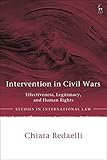Intervention in Civil Wars : Effectiveness, Legitimacy, and Human Rights / Chiara Redaelli
Material type: TextSeries: Studies in International LawPublication details: Oxford, UK; New York, USA Hart Publishing, an imprint of Bloomsbury Publishing, 2021Edition: First EdDescription: xxxviii, 302p. : ill. ; 23cmISBN:
TextSeries: Studies in International LawPublication details: Oxford, UK; New York, USA Hart Publishing, an imprint of Bloomsbury Publishing, 2021Edition: First EdDescription: xxxviii, 302p. : ill. ; 23cmISBN: - 9781509947058 (paperback)
- 9781509940547 (hardback)
- 23rd 341.68 RED
| Item type | Current library | Call number | Copy number | Status | Notes | Date due | Barcode | |
|---|---|---|---|---|---|---|---|---|
| Reference Book | VIT AP School of Law LAW Section | 341.68 RED (Browse shelf(Opens below)) | LA02215 | Not for loan | LAW | 021067 |
It includes Acknowledgements, Abstract, Abbreviations, Table of Cases, Table of Treaties and National Legislation, Table of Documents and Resolutions, Bibliography and Index Pages.
Table of Contents :
PART I
SOVEREIGNTY, INTERVENTION, AND HUMAN RIGHTS: THE EVOLUTION OF A CLOSE RELATIONSHIP
1. Interventions in Internal Conflicts in the Pre-Charter Era
I. The Use of Force as Crucial Prerogative of State Sovereignty: From Bellum Justum Doctrines to the Right to War
A. Just War Doctrines
B. The Right to Wage War
II. The Emergence of the Principle of Non-intervention as Fundamental Rule Protecting Sovereignty
III. Interventions in Internal Conflicts before the General Ban on the Use of Force
IV. Concluding Observations
2. Intervention and Use of Force in the United Nations Era
I. Interventions in Internal Conflicts
II. The Ban on the Use of Force
III. Non-intervention, Sovereignty, and Human Rights
IV. Concluding Observations
PART II
INTERVENTIONS IN FAVOUR OF GOVERNMENTS
3. Interventions by Invitation between Legitimacy and Effectiveness
I. Intervention by Invitation: The Legal Framework
II. Negative Equality or Strict Abstentionism Approach
III. The Purpose-based Approach
IV. Effectiveness Doctrine: De Facto Control as Requisite to Express a Valid Consent
V. Democratic Entitlement Doctrine: The Preference for Democratic Governments
VI. Concluding Observations
4. Intervention by Invitation and Governmental (Il)legitimacy: Rethinking the Traditional Approaches
I. Governmental Legitimacy: Legitimacy of Origin and Legitimacy of Exercise
II. Democratic but Ineffective Governments
III. Undemocratic Regimes and Effectiveness
IV. The Role of Domestic Constitutional Orders in International Law
V. Concluding Observations
5. Interventions in Favour of Governments Committing Gross and Systematic Violations of Human Rights
and Humanitarian Law
I. Protection of Individuals and Legitimacy: Framing the Discussion
II. Illegitimate Governments and the Question of Consent Power
III. Limitations to the Possibility to Intervene in Favour of Governments that Commit Gross and Systematic
Violations of Human Rights
IV. Humanitarian Assistance and the Consent of the Government
V. Concluding Observations
PART III
INTERVENTIONS IN FAVOUR OF REBELS
6. Legitimacy of Rebels in International Law
I. National Liberation Movements as Legitimate Representatives of a People
II. Legitimising Rebels Outside the Decolonisation Context: New Wine in Old Bottles?
III. Concluding Observations
7. Use of Force by and against Legitimate Rebels: Towards the Emergence of a Jus ad Bellum Applicable to Internal Armed Conflicts?
I. State Use of Force and Legitimate Rebels
II. Legitimate Rebels and the Use of Force
III. Concluding Observations
8. Interventions in Favour of Rebels and Human Rights
I. Rebels' Recognition and Foreign Interventions
II. Helping Rebels in the Exercise of their Right to Self-determination
III. Responsibility to Protect and Interventions in Favour of Rebels
IV. Concluding Observations
9. Conclusions
I. The Shift from Legitimacy to Effectiveness and Back
II. The Dangers of Legitimacy
III. A Final Word
Description
This book investigates the extent to which traditional international law regulating foreign interventions in internal conflicts has been affected by the human rights paradigm. Since the adoption of the Charter of the United Nations, foreign armed interventions in internal conflicts have turned into a common practice. At first sight, it might seem that state practice has developed in a chaotic fashion, however on closer examination, specific patterns emerge. The book charts these patterns by examining the traditional doctrines of intervention and testing them against state practise.
The book has two aims. Firstly, it seeks to clarify the current legal framework regulating interventions in internal conflicts. Secondly, it plots the emergence of new trends and investigates whether they are becoming part of positive international law. By taking this dual focus, it offers the first truly comprehensive examination of foreign interventions in internal conflicts.
There are no comments on this title.

